Baneh
Baneh (Persian: بانه, romanized: Bāneh,[2] Kurdish: Bane ,بانە[3][4]) is a city and capital of Baneh County, Kurdistan Province, in Iran's western border. Baneh is bordered by Saqqez to the east, Marivan to the south, Sardasht to the west, and is approximately 30 km (18 miles) from the Iraqi province of Iraqi Kurdistan. According to the 2016 census, the city has a population of 115,325. After the cities of Sanandaj, Marivan and Saqqez, Baneh is the fourth largest city in Kurdistan province and the 109th-largest in Iran.[5] Located in the heart of the Zagros Mountains, the vicinity is known for its unique oak forests.
Baneh
بانه | |
|---|---|
City | |
 Baneh | |
| Coordinates: 35°59′51″N 45°53′07″E | |
| Country | |
| Province | Kurdistan |
| County | Baneh |
| Bakhsh | Central |
| Area | |
| • City | 1,584.5 km2 (611.8 sq mi) |
| Elevation | 1,554 m (5,098 ft) |
| Population (2016 Census) | |
| • Urban | 110,218 [1] |
| Time zone | UTC+3:30 (IRST) |
| • Summer (DST) | UTC+4:30 (IRDT) |
| Area code(s) | 087-342 |
| Website | http://www.banehcity.ir/ |
Appellation
Baneh name from the Kurdish word "Ban (Kurdish:بان)" meaning "roof" long and by the height and know how to deploy and position of Baneh. 1554 meters of height above sea level and the heights of the surrounding landscape is made possible to reach people in a large way to the uphill travel.
Geography
Location
City of Baneh is located in West mountainous and forested region of Kurdistan province which is surrounded by mountains like Arbaba (آرببا), Jnireh (جنیره), Babos (بابوس) and Dozin (دوزین). the geographical coordinates of Baneh is longitude 45 degrees 53 minutes latitude and 35 degrees 59 minutes.[6]
Climate
Baneh has cold winters and mild summers and also air temperature difference of twenty degrees below zero to thirty-six degrees above zero. The amount of annual precipitation is 921 mm.
History
Before Islam
Pre-Islamic Zoroastrian nation called "Qaqo (Kurdish:قهقو)" ruled on the region and in the Arab invasion of Iran and then took it to Ekhtiyaredinis (Persian: اختیارالدینی) Until the middle of the thirteenth century AD. the original name of the city of Baneh is Barozha (Kurdish: بهروژه)(mean:sunflower) and There are also documents that in all of them the base of Baneh, is the village that was called Barozha.
Safavid
Around the time of the Safavid usually guarding the Iranian border, from the city of Kermanshah to Khoy was assigned to rulers of Baneh. Governors of Baneh and Uraman holds the title of "King". Some authors believe that this title was given to them by Nader Shah Afshar.
World War I
The city once before World War I and again in World War II was a burnt fiercely. The northeast cemetery of the city, is called "Baneh kon (Kurdish: بانه کۆڹ; Persian: بانه کهنه)". The rename and displacement reason of the city was due to cholera and plague epidemic diseases that were common every few years and then survivors, assumed the primary site infected and created the city somewhere else. Fires and tribal conflict was another cause of the displacement of city.
People
Language
Sulaymaniyah Sorani Kurdish dialect is the language of Baneh.
Religion
Baneh is Sunni Muslim and their religion is Imam Shafi'i. There was a Jewish minority in Baneh, whose number was over forty families. After Israel declared independence in 1948 and the partition of Palestine, they thinking about immigration to Palestine in 1327 solar and in late 1328 immigrated and left Baneh completely. At the same time, Sardasht, Saqqez, Bokan and Marivan Jews and part of Sanandaj and Mahabad and Piranshahr Jews also emigrated. There are two theories about Jewish settlement in the West, the first one stated that the first Baneh Jewish settlement happened in the year 136 AD during the Barkoshbas (Persian: بارکوشباس) revolt against Roman government and the dispersal of Jews around the world, and second, relates this issue to Tiglate Placer king of Assyria in 741 to 749 BC, after the conquest of Jerusalem by the Placer more than sixty thousand Jews exiled in parts of the West of Iran, Median land, south of the Caspian Sea and the Caucasus Mountains.
People
- Ebrahim Younesi, writer and translator
- Bahman Ghobadi, director and writer
- Ata Nahaei, novelist and translator
- Farrokh Nematpour, novelist and translator
- Taha Karimi, director and writer
- Ebrahim Alipour, photographer
- Mahindokht Motamedi, poet and university lecturer
- Keywan Karimi, director
Economy and Tourism
Economy
Since the mid-70s cross-border trade flourished in Baneh. One of its effects, commodity prices were coming down. That's why the field of making shopping malls for selling cross-border cheaper goods arose, that to this date nearly 110 shopping centers have been built in the city. This process during 20 years made Baneh to become an important economical hub in the country. Annual circulation of money reaches more than 100 million dollars.
Tourism
After flourishing the economy and trading in Baneh, people all around the country made Baneh, one of their traveling destination goals to buy the cheaper goods. Annually Baneh is visited by more than 2 million tourists. Baneh also has a very beautiful and astonishing nature, jungle parks and untouched forests and advancing in the tourism industry also has made the city a fine place for travelers.
| Name | Grade | Address | |
|---|---|---|---|
| 1 | Haleh international hotel | 5 star | Farmandary Square |
| 2 | Arian hotel | 3 star | Shora square |
| 3 | Shar hotel | 3 star | Bilal Habashi boulevard |
| 4 | Zana hotel | 3 star | Saqqez boulevard |
| 5 | Saman hotel | 2 star | Sardasht boulevard |
| 6 | Setare Talaei hotel | 2 star | 15th Khordad square |
Gallery
 View of the city from Dokanan Park
View of the city from Dokanan Park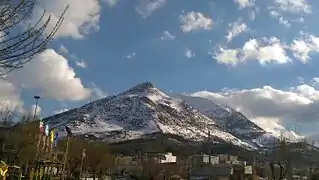 View of Arbaba on a winter's day
View of Arbaba on a winter's day Baneh by day
Baneh by day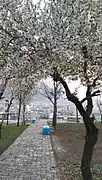 Shahr Park in spring
Shahr Park in spring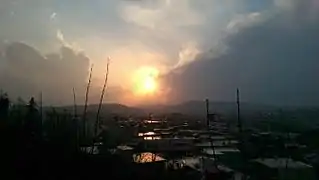 Rainy day, dusk view from Shahr Park
Rainy day, dusk view from Shahr Park Haleh International 5-Star hotel
Haleh International 5-Star hotel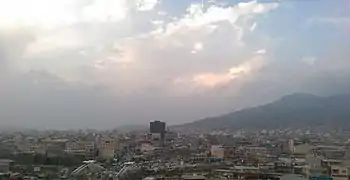 Behesht Shopping Center
Behesht Shopping Center Aftab Derakhshan shopping center
Aftab Derakhshan shopping center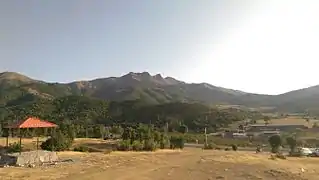 Sooren plain and forest
Sooren plain and forest Arbaba forest
Arbaba forest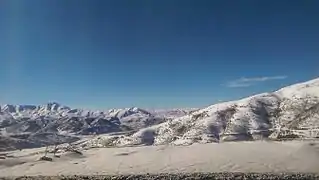 Snow covered Kali Khan
Snow covered Kali Khan


References
- https://www.amar.org.ir/english
- Baneh can be found at GEOnet Names Server, at this link, by opening the Advanced Search box, entering "-3055216" in the "Unique Feature Id" form, and clicking on "Search Database".
- "ئێوەش پشتیوانی ماڵی ڕێکخراوی مافی مرۆڤیی"هەنگاو" بن" (in Kurdish). Retrieved 21 March 2020.
- "Hengaw- Li devera Bane ya Rojhilatê Kurdistanê kolberekî kurd di encama êrişa pasdarên Îranê de hat kuştin" (in Kurdish). Retrieved 21 March 2020.
- "Census of the Islamic Republic of Iran, 1385 (2006)". Islamic Republic of Iran. Archived from the original (Excel) on 2011-11-11.
- A. Mardūḵ, "Bāna", Encyclopaedia Iranica
| Wikimedia Commons has media related to Baneh. |
